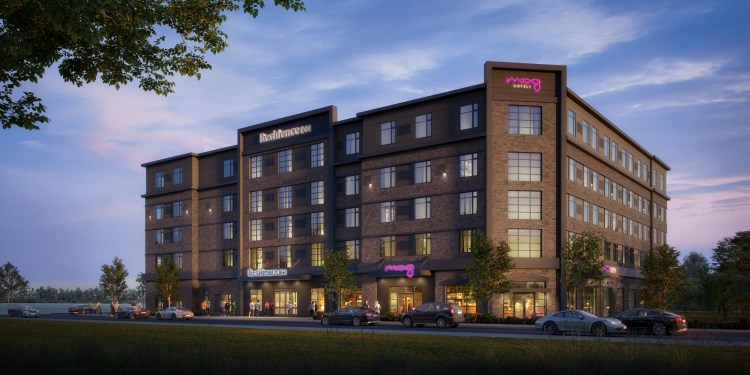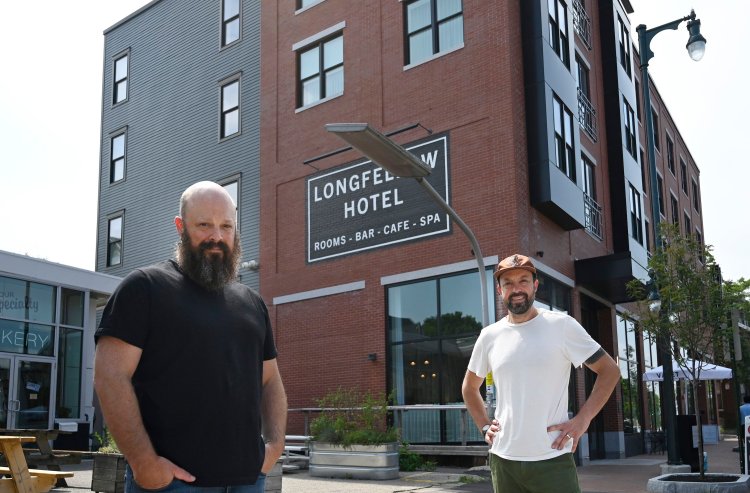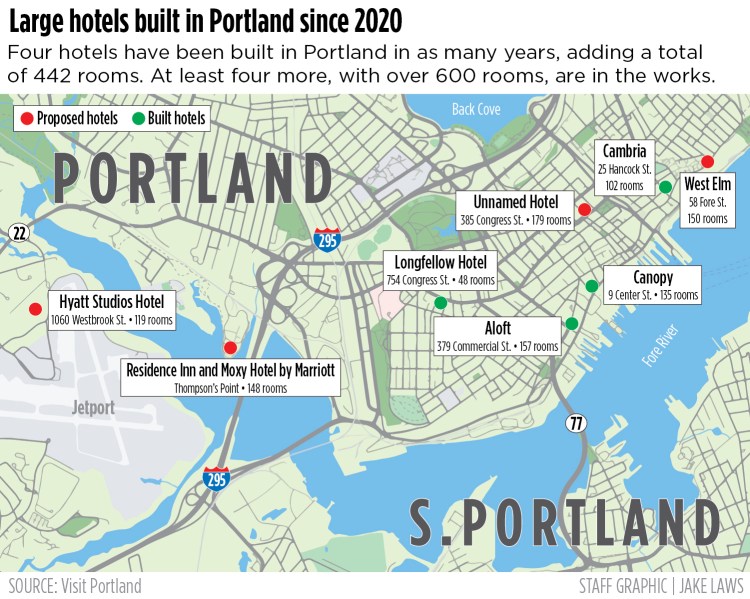

Brothers and co-owners of the Longfellow Hotel, Tony, left, and Nate DeLois inside the Congress Street business in Portland on Friday. The hotel opened in May. Shawn Patrick Ouellette/Staff Photographer
An increase in leisure and business travel to Portland over the last decade has prompted a hotel building boom that promises to bring hundreds of hotel rooms to the region. Every time a developer floats a new hotel proposal, the same questions arise: Do we really need another hotel? Can the city even absorb that many rooms?
Industry experts say the answer to both questions is yes.
Portland’s busy season has extended further into the fall, and Visit Portland, the regional tourism bureau, is working to boost winter tourism while investments in the area by large companies like Wex, The Roux Institute and Covetrus have drummed up more business travel. Several new hotels have cropped up – about 1,250 new hotel rooms have come online in the last 10 years – and the market has remained strong.
Occupancy rates in the summer and in the offseason are higher than the national average. Revenue has gone up more than 100% in the last decade.
And developers have noticed.
PROJECTS IN THE PIPELINE
The city has added nearly 450 rooms in the last four years alone. Canopy Hotel on Center Street and Aloft on Commercial Street opened in 2021, adding 135 and 157 rooms, respectively. Cambria Hotel on Hancock Street followed suit in 2022 with an additional 102 rooms, and The Longfellow Hotel on Congress Street added 48 rooms to the market when it opened in May.
And there are plenty more in the pipeline.
Portland has at least 750 hotel rooms in various stages of the planning process, and there are more than 400 in the works in the surrounding area.
That would mean a more than 22% increase from the current inventory of about 3,400 rooms in Portland and a roughly 14% increase from the 8,300 rooms in Greater Portland.
The 148-room Residence Inn & Moxy Hotel by Marriott in Thompson’s Point started site work this year and is expected to open in 2026. But other timelines remain unclear.
The most recent project, a 119-room Hyatt Studios Hotel near the Portland International Jetport, was approved last week.
Others include 179 rooms planned for the as-of-yet unnamed hotel at 385 Congress St and 150 rooms on Fore Street built by furniture retailer West Elm. Element by Westin is planning 122 rooms at Rock Row in Westbrook.
It will be years before most of the other projects can add rooms to the market. They may not even be built at all.
“Just because someone says they’re building a hotel doesn’t mean it’s going to get built,” said Matthew Arrants, principal at hotel investment and consulting firm The Arrants Company. “Right now, it’s very difficult to get any new hotel built because of the combination of high interest rates and construction costs.”


An artist’s rendering of a planned hotel at Thompson’s Point in Portland. Courtesy of XSS Hotels
Jim Brady, president of Fathom Companies, said the hospitality management and development company is hoping for more competitive pricing before moving forward with the project at 385 Congress, which also includes nine condominiums.
“High construction costs are making it challenging to develop ground-up projects, which do not benefit from historic tax credits,” he said.
Public pressure to build more housing also has been mounting.
Lynn Tillotson, executive director of Visit Portland, acknowledged that for some, adding more hotels can be a hard pill to swallow when the city so desperately needs additional housing, but she said there needs to be a balance.
“I think we need to remember, visitation to our state and especially our Greater Portland community is essential,” she said. “We as a community can’t sustain everything on our own.”
Tony DeLois, co-owner of Uncommon Hospitality, agreed that as the tension around the housing crisis and development has ratcheted higher, so has criticism of plans for new hotels.
“When a building goes up and it looks like a duck and it walks like a duck, people say ‘Well, just make it housing,’ ” he said. But it’s not always that simple. The site of the newest Uncommon Hospitality project, the Longfellow Hotel, for example, was previously a gas station. The cost of environmental mitigation required to make it suitable for housing would have been astronomical, he said.
But at the same time, proposed housing projects – affordable and otherwise – all over the state also have faced resistance. Portlanders have long been bearish on development, he said, and it’s causing growing pains as the city tries to find a way to meet everyone’s needs.
ROOM TO GROW
Arrants, the adviser, said the region’s growth is a good thing. He is confident the market can support the projects that make it past the finish line.
The 8,000-room inventory in Greater Portland – which includes surrounding towns such as Westbrook, South Portland, Scarborough and Falmouth – is relatively small compared to similarly sized cities or metro areas, Arrants said. Savannah, Georgia, for example, has about 14,000 rooms and the Charleston, South Carolina, metropolitan area has about 19,000 rooms.
The relatively strong occupancy rate, especially in the summer, he said, suggests that there is unmet demand. There is room to grow.
Greater Portland’s hotel occupancy rate swings dramatically between summer and winter. In the last five years, pandemic notwithstanding, the average occupancy rate has fluctuated between 75% and 80% in June and between 50% and 60% in December.
Last December, the occupancy rate was 56.5%, according to CoStar, a commercial real estate company. In June, it was 77.1%.
The rest of the country saw a 52.6% occupancy rate in December 2023 and a 69.9% occupancy rate in June.
Supply, or the number of room nights available, increased 23% between 2013 and 2023, while revenue increased 113%, according to data from CoStar.
Nationally, supply increased 11% over the same period and revenue jumped 58%.
“It’s been a very resilient market,” Arrants said of Portland. “These numbers are huge by industry comparison.”
Hotel construction is booming nationally, too.
The U.S. had over 157,000 hotel rooms under construction in June, more than almost any other country, according to CoStar.
A NICHE TO FILL
Tony and Nate DeLois started turning away guests almost daily just a few months after opening The Francis in 2017, the 15-room mansion-turned-hotel on Congress Street.
“We kept saying, ‘If we just had more rooms,’ ” Tony DeLois said. And thus started the 5 ½-year journey to open The Longfellow Hotel, a 48-room boutique hotel across the street from The Francis. It opened in May.
DeLois said he saw a hole he could fill. “In my mind there was a niche to be filled in the small- to midsized hotel market,” he said.


Brothers Nate, left, and Tony DeLois outside their 48-room Longfellow Hotel in Portland’s West End. Shawn Patrick Ouellette/Staff Photographer
People are drawn to Portland’s small-business-minded “entrepreneurial spirit,” he said, but their options for lodging are often large-scale corporate-owned entities.
The Longfellow is still on the smaller side, with 48 rooms. The Portland Regency Hotel and Spa, opened in 1987, is the next step up in size, with 95 rooms.
DeLois isn’t worried about too much competition in the marketplace. He’s seen hotel booms before, and so far, he’s pleased with occupancy at the two Portland hotels.
A flurry of development 10 years ago added more than 500 rooms in 2014 and 2015 and it was a boon for the city.
“The more hotel rooms we built, the more occupied everyone became,” he said of the city. “There can definitely be more hotels.”
Around the same time, Portland started to rise as a major destination city rather than a pass-through. The hotels were pivotal in helping that transformation, DeLois said.
To sustain this next wave of hotels, though, marketing Portland as a year-round destination will be critical.
“We’re busting at the seams in the summer, but come January it’s like, ‘OK, where is everybody?’ ” he said.
WINTER WILL BE KEY
Visitation has leveled off from the “revenge travel” phenomenon – the 2021 and 2022 tourism frenzy following the pandemic lockdowns, said Tillotson, of Visit Portland.
As a whole, tourism in Maine was a mixed bag last year. About 15 million people came to the state in 2023, a slight dip from 2022, but they spent more money – about $9.1 billion, up from $8.6 billion – and stayed for longer, according to the state Office of Tourism.
With better weather and more robust summer staffing, business owners are reportedly feeling optimistic for a stronger 2024 summer season.
Maine’s busy season has been extending later into the autumn each year, with hotel owners reporting strong numbers into November. But winter remains a challenge for the tourism-dependent businesses. Visit Portland is trying to change that.
In June, city leaders approved a tourism development district to support the organization.
The district charges a 1.5% guest fee at hotels throughout the city with at least 40 rooms. It doesn’t add much to a guest’s bill – about $2.50 for the average $163 room rate – but across the roughly two dozen qualifying hotels, it’s expected to bring in nearly $2 million a year, more than doubling Visit Portland’s budget, Tillotson said.
Most of the money is intended to boost Visit Portland’s efforts to promote the city as a must-see destination at any time of year, not merely the popular summer months.
This will be especially crucial if the city is to accommodate more hotel rooms.
“To really focus on winter visitation is key,” Tillotson said. “We’re Maine, and in the summer and fall, visitors will come. Our focus as a destination marketing association is to promote the city year-round.”
Related Stories
(Except for the headline, this story has not been edited by PostX News and is published from a syndicated feed.)



